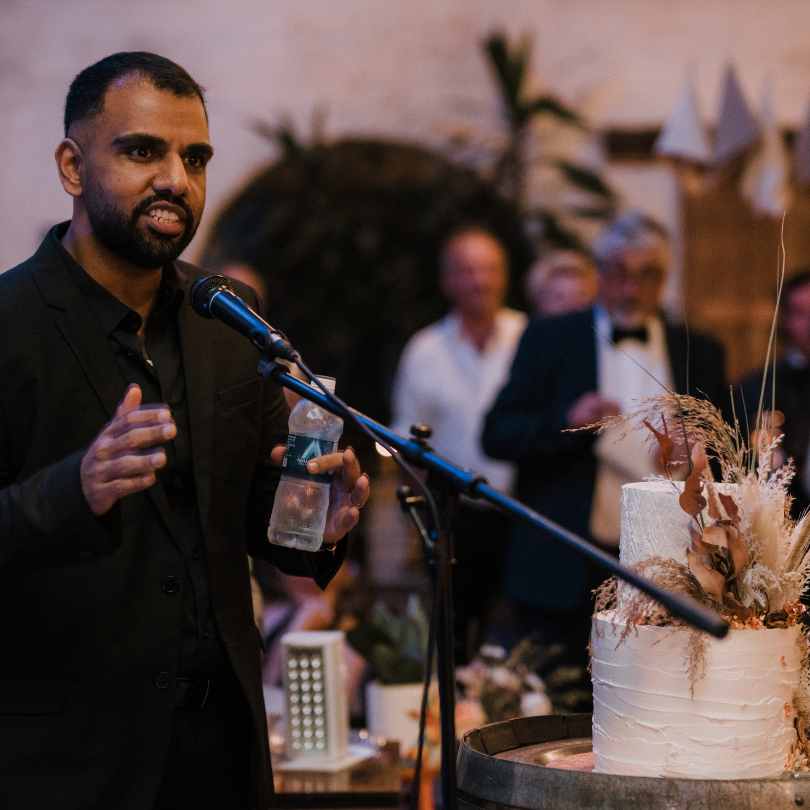
The marriage ceremony is the most important part of planning a wedding, yet it’s often the area that couples have the most questions about. The legality and traditional aspects vary by state and also by the style of ceremony, so there isn’t always a clear path to follow. Here are five of the most commonly asked questions about wedding ceremony planning and advice for how to find the answer.
1. How long should my ceremony be?
Standard wedding ceremonies are usually between 20 and 30 minutes. However, the length depends on what style of ceremony you’re having, the length of the vows, and if you choose to incorporate any additional things such as a unity ceremony. A standard non-denominational or non-religious ceremony typically runs about 20 minutes. A Jewish ceremony can be anywhere between 25 and 45 minutes, and a traditional Catholic ceremony can last up to an hour. Be sure to discuss the length of time and any additional traditions you’d like to include with your wedding officiant.
2. Who should marry us?

Your wedding officiant is likely going to be based on the type of ceremony you’re having. For religious ceremonies, it’s typical for a religious leader of the faith to perform the ceremony. For non-religious ceremonies, the officiant needs to be licensed to perform weddings based on individual state laws. These officiants can vary from professional officiants who have been trained in wedding ceremonies, to family and friends who have gone through the process of becoming legally ordained. Be sure to check your individual state guidelines while making your officiant choice. It’s also a good idea to interview your officiant before finalizing your choice. Ask for examples of the ceremony they’ll be performing and communicate any ideals that are important to you and any that you do not wish to be included.
3. When do we get the marriage license?
It’s best to get the marriage license well before the wedding day to ensure you have it on time. Make an appointment or contact your local county clerk for your state guidelines for obtaining your marriage license. When getting the license, ask the clerk if there is an expiration date and how to mail the signed copy from the wedding back to the office. Conveniently, most offices now give couples a wedding packet with frequently asked questions and guidelines for the process.
4. What is the best time to start?

Your ceremony can happen at any time of the day that you’d like! It can even be held on a completely separate day as your reception! When planning the timing for your ceremony, start by thinking about the venue and the time of day that you’d like to walk down the aisle. Next, think about where your reception will be in relation to your ceremony. Lastly, think about your dinner/meal plans. For example, a summer wedding that is outside could follow this process:
The ceremony is outside and it’s going to be warm. You might like to wait until the sun is past its height to achieve the “golden hour” for photos and so that guests (and yourself) don’t melt.
The ceremony is in a different location than the reception. You’ll need to factor in travel time for everyone to arrive at the reception on time.
Time the ceremony with food service in mind. Your ceremony may only be 30 minutes, but remember that photos are usually taken between the time of the ceremony and the reception. A typical dinner is served anywhere between 6:30pm and 7:30pm. If your ceremony is too early, you run the risk of guests leaving before dinner is even served. (No one wants to pay for meals that guests don’t eat!) If it’s too late, you may not have time for photos or to freshen up before the meal is served.
5. In what order should the bridal party walk down the aisle?
Once the guests are seated and the officiant takes their place, the pre-processional begins with the seating of any designated family members, such as the mothers of the bride and groom or grandparents. The processional consists of the bridal party who file in from the furthest away in line from the couple first, to the bride’s main entrance at the end. The groom can either escort one or both of the mothers down the aisle before taking his place next to the officiant, or he can take his place at the same time as the officiant. The ceremony order will likely be dependent on the style of the ceremony and who is in the bridal party. Here is a an example processional order to reference:
Pre-processional
Seating of grandparents
Seating of mothers
Processional
Bridesmaid and groomsmen furthest away from bride and groom
Maid/matron of honor and best man
Flower girl and ring bearer
Bride and escort
Your wedding ceremony is entirely customizable by you and your fiancé. Discuss what items of tradition are important to you both and communicate them with your officiant. Lastly, be sure to look up your individual state laws before solidifying any of your plans.
The post 5 Commonly Asked Questions About Wedding Ceremony Planning appeared first on Weddingbee.


















